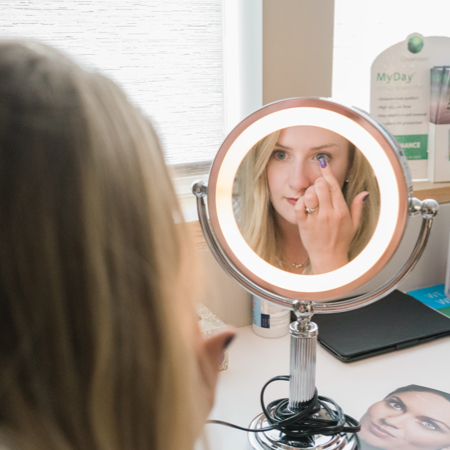In this digital age we’re spending more and more time in front of screens and so are our kids. Studies show that the odds of visual issues developing in children increase after 2-4 hours of screen time. More screen time leads to higher risk of digital eye strain.
Making sure your child visits the optometrist regularly is a great way to protect even the littlest eyes. There are also steps you can take at home to prevent digital eye strain. Let’s explore them.
What is Digital Eye Strain?
The more time we spend in front of tablets, televisions, smartphones, and computers, the harder our eyes have to work. Eye discomfort and vision problems can result from all this extended screen time.
Also known as computer vision syndrome, digital eye strain is uncomfortable and can make the eyes susceptible to serious, long-term vision problems.
Risks Associated With Digital Eye Strain
Too much screen time puts children at risk for a variety of health issues. These include:
- Poor sleep quality
- Poor school performance
- Cognitive delays
- Higher risk of obesity
- Delayed social development
Symptoms of Digital Eye Strain
Children typically don’t notice eye strain as much as adults do but the symptoms are largely the same. Here’s what to watch out for:
- Sore and tired eyes
- Blurry or double vision
- Difficulty concentrating
- Neck or back pain
- Watery or dry eyes
10 Tips to Prevent Digital Eye Strain in Children
1. Block Blue Light
Screens emit blue light. This type of visible light is not as easily focused by the eyes and can lead to eye strain. Blue light also inhibits melatonin production and can interfere with your child’s sleep schedule.
The Canadian Association of Optometrists recommends that children’s exposure to blue light should be monitored and controlled.
Filters and apps for devices can be used to block blue light. If your child wears glasses, your optometrist can help you with blue light blocking lenses.
2. Proper Posture
Maintaining proper posture can alleviate some of the back and neck pain associated with screen time. Your child shouldn’t be hunched over with their shoulders rounded.
Their head and neck should be upright and in line with their torso. Their device should be straight ahead so they can face the screen directly, without turning or twisting their neck or back.
3. Screen Settings
Make sure screens aren’t too bright and text isn’t too small. If font size is hard to read it will put even more strain on the eyes so increase the size to something easily readable. There’s plenty of information available online about how to change the settings on your child’s particular device.
4. Device Distance
Screens should be approximately arm’s length away from your child. The top of a computer monitor should be at your child’s eye level. If using a computer, the mouse and keyboard should be within comfortable reach.
5. 20-20-20
For every 20 minutes spent looking at the screen, have your child look at something 20 feet away for 20 seconds. The 20-20-20 rule can help exercise eyes and reduce strain. It allows eyes a chance to focus.
This quick break is also a good time to blink. On average, people blink 12 times each minute but when they’re in front of a screen, that number goes down to 5. Not enough blinking can lead to dry eyes, increasing the irritation associated with digital eye strain.
6. Lighting Levels
When using a computer, the room’s lighting level should be half as bright as a normal classroom. If there’s too much light it might cause glare and reflection which makes it harder for eyes to adjust. Anti-glare screen protectors are also helpful.
7. Fingerprint-Free
Little fingers love to touch screens but fingerprints can make it harder to see and harder to focus. Keep screens free of dust and dirt to increase visual clarity.
8. Whole-Body Breaks
Kids should take breaks from screens every 30-60 minutes. These breaks should incorporate whole-body physical activity. The Canadian Association of Optometrists recommends outdoor breaks.
9. Workstation Situation
Workstation ergonomics can help prevent digital eye strain. If your child is working at a desk, ensure the desk is elbow height or slightly lower. The desk should also have forearm support.
Children’s feet should be able to lay flat on the floor. If they can’t, put a stool underneath their feet so the body is supported. If chairs have arm or back rests, they should fit your child perfectly.
10. Annual Eye Exams
Children might not complain about the symptoms associated with digital eye strain. It’s important to take them for an annual eye exam to ensure the long-term health of their vision.
Don’t Ignore Digital Eye Strain
Digital devices are here to stay, so make sure you’re taking the steps to protect your child’s vision when using them.
If your child notices any of the symptoms of digital eye strain make sure to bring them to the optometrist for a comprehensive eye exam. It’s important to rule out other, more serious issues.
















